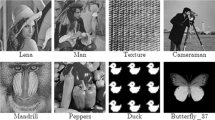Abstract
Moment invariants that are not affected by geometric transform have been utilized as pattern features in a number of applications. But in most cases, images are processed subject to blur degradations. The traditional blur invariant sets were constructed using geometric moments, central moments or complex moments. However, these non-orthogonal moments are generally considered as a disadvantage over orthogonal moments, such as Zernike, pseudo-Zernike, and Legendre moments, in decreasing information redundancy and sensitivity to noises. To solve this problem, this paper addresses a method for recognizing objects in an image in a way that is invariant to images’ blur and rotation transformations to improve the robustness to noises. The proposed method is based on Zernike descriptors which are orthogonal over a unit circle, and is invariant to a central symmetric blur, such as linear motion or out-of-focus blur. We present a mathematical framework of obtaining the Zernike moments of blurred images, and a framework of deriving the combined blur and rotation invariants. The classification experimental results are presented to confirm the proposed method outperforms other similar ones in the presence of various blur-degraded and rotation-transformed images.








Similar content being viewed by others
Explore related subjects
Discover the latest articles and news from researchers in related subjects, suggested using machine learning.References
Wang X, Xiao B, Ma JF, Bi XL (2007) Scaling and rotation invariant analysis approach to object recognition based on Radon and Fourier–Mellin transforms. Pattern Recognit 40:3503–3508
Heikkilä J (2004) Pattern matching with affine moment descriptors. Pattern Recognit 37:1825–1834
Ping Z, Ren H, Zhou J, Sheng Y, Bo W (2007) Generic orthogonal moments: Jacobi–Fourier moments for invariant image description. Pattern Recognit 40:1245–1254
Zhang F, Liu SQ, Wang DB, Guan W (2008) Aircraft recognition in infrared image using wavelet moment invariants, Image and Vision Computing (in press)
Yang JC, Park DS (2008) A fingerprint verification algorithm using tessellated invariant moment features. Neurocomputing 71:1939–1946
Yang CY, Chou JJ (2000) Classification of rotifers with machine vision by shape moment invariants. Aquac Eng 24:33–57
Lin YH, Chen CH (2008) Template matching using the parametric template vector with translation, rotation and scale invariance. Pattern Recognit 41:2413–2421
Hu MK (1962) Visual pattern recognition by moment invariants. IRE Trans Inf Theory 8:179–187
Reiss TH (1991) The revised fundamental theorem of moment invariants. IEEE Trans Pattern Anal Mach Intell 13:830–834
Flusser J, Suk T (1993) Pattern recognition by affine moment invariants. Pattern Recognit 26(1):167–174
Flusser J, Suk T, Saic S (1996) Recognition of blurred images by the method of moments. IEEE Trans Image Process 5(3):533–538
Banham MR, Katsaggelos AK (1997) Digital image restoration. IEEE Signal Process Mag 14(2):24–41
Ojansivu V, Heikkilä J (2008) A method for blur and affine invariant object recognition using phase-only bispectrum. Springer, ICIAR, LNCS 5112, pp 527–536
Flusser J, Suk T (1998) Degraded image analysis: an invariant approach. IEEE Trans Pattern Anal Mach Intell 20:590–603
Flusser J, Zitová B (1999) Combined invariants to linear filtering and rotation. Int J Pattern Recognit Artif Intell 13:1123–1136
Zhang Y, Wen C, Zhang Y, Soh YC (2002) Determination of blur and affine combined invariants by normalization. Pattern Recognit 35:211–221
Flusser J, Suk T (2003) Combined blur and affine moment invariants and their use in pattern recognition. Pattern Recognit 36:2895–2907
Liu J, Zhang T (2005) Recognition of the blurred image by complex moment invariants. Pattern Recognit Lett 26:1128–1138
Ghorbel F, Derrode S, Mezhoud R, Bannour T, Dhahbi S (2006) Image reconstruction from a complete set of similarity invariants extracted from complex moments. Pattern Recognit Lett 27:1361–1369
Mukundan R, Ramakrishnan KR (1998) Moment functions in image analysis—theory and applications. World Scientific, Singapore
Khotanzad A, Hong YH (1990) Invariant image recognition by Zernike moments. IEEE Trans Pattern Anal Mach Intell 12(5):489–497
Butterfly database: http://museumvictoria.com.au/bioinformatics/butter/images/bthumbliv.htm
MPEG7 CE Shape-1 Part B: http://www.imageprocessingplace.com/root_files_V3/image_ databases.htm
Acknowledgment
The authors would like to thank the anonymous referees for their helpful comments and suggestions.
Author information
Authors and Affiliations
Corresponding author
Appendices
Appendix A: Proof of Theorem 1
In this appendix, we detail a derivation of Theorem 1. According to (8), we obtain the following expression.
From (15) and (8), we can obtain the following expression of radial moments after blurring degradation.
Appendix B: Proof of theorem 2
Proof of \( Z_{pp}^{g} = Z_{pp}^{f} \)
According to (15), if p = q, Zernike moments \( Z_{pq}^{g} \)of an image after Gaussian blurring becomes
From (7), we can obtain the radial moments in PSF form as
where g i g j is the central moment of Gaussian PSF, according to the conclusion drawn by Flusser and Suk [14] and Liu and Zhang [18] we have
and
Then, from (18–20) we have the following conclusions:
-
(1)
If p − m is odd, whether t is odd or even, \( D_{p - m,p - m}^{h} = 0 \).
-
(2)
If p − m is even and t is odd, \( D_{p - m,p - m}^{h} = 0 \).
-
(3)
If p − m is even and t is even
Let t = 2k, then
where
Substitute (22) and (23) into (21), we get
Due to the fact that imaging system is energy preserving, i.e.,\( \iint_{{R^{2} }} {h(x,y)\hbox{d}x\hbox{d}y = 1} \), thus, we have
While p = q, \( p \ne m \),\( D_{p - m,p - m}^{h} = 0 \). Substituting \( D_{p - m,p - m}^{h} = 0 \) into (17), we get
Therefore, when p = q, and \( Z_{pp}^{g} = Z_{pp}^{f} \)
Rights and permissions
About this article
Cite this article
Zhu, H., Liu, M., Ji, H. et al. Combined invariants to blur and rotation using Zernike moment descriptors. Pattern Anal Applic 13, 309–319 (2010). https://doi.org/10.1007/s10044-009-0159-9
Received:
Accepted:
Published:
Issue Date:
DOI: https://doi.org/10.1007/s10044-009-0159-9




